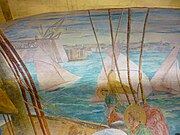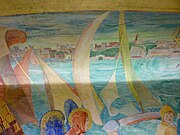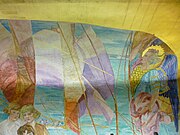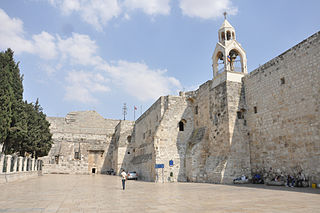
The Church of the Nativity, or Basilica of the Nativity, is a basilica located in Bethlehem, West Bank, Palestine. The grotto holds a prominent religious significance to Christians of various denominations as the birthplace of Jesus. The grotto is the oldest site continuously used as a place of worship in Christianity, and the basilica is the oldest major church in the Holy Land.

Benedetto Bonfigli was an Italian Renaissance painter born in Perugia, and part of the Umbria school of painters including Raphael and Perugino. He is also known as Buonfiglio. Influenced by the style of Domenico Veneziano, Benozzo Gozzoli, and Fra Angelico, Bonfigli primarily painted frescos for the church and was at one point employed in the Vatican. His best-preserved work is the Annunciation, but his masterpiece is the decoration of the chapel of the Palazzo dei Priori. Bonfigli specialized in gonfaloni, a Perugian style using banners painted on canvas or linen. Little is known of his personal life, but he was an esteemed painter in Perugia before Perugino, who is said to be his pupil.

Ethel Campbell Louise Anderson was an early twentieth century Australian poet, essayist, novelist and painter. She considered herself to be mainly a poet, but is now best appreciated for her witty and ironic stories. Anderson has been described as "a high-profile author, artist, art commentator and emissary for modernism".

The Cathedral Church and Minor Basilica of the Immaculate Mother of God, Help of Christians, Patroness of Australia is the cathedral church of the Roman Catholic Archdiocese of Sydney and the seat of the Archbishop of Sydney, currently Anthony Fisher OP. It is dedicated to the "Immaculate Mother of God, Help of Christians", Patroness of Australia and holds the title and dignity of a minor basilica, bestowed upon it by Pope Pius XI on 4 August 1932.

The Basilica of Saint Francis of Assisi is the mother church of the Roman Catholic Order of Friars Minor Conventual in Assisi, a town in the Umbria region in central Italy, where Saint Francis was born and died. It is a papal minor basilica and one of the most important places of Christian pilgrimage in Italy. With its accompanying friary, Sacro Convento, the basilica is a distinctive landmark to those approaching Assisi. It has been a UNESCO World Heritage Site since 2000.
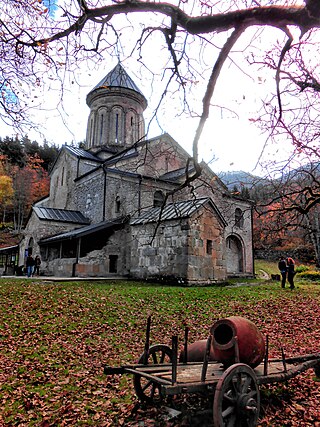
Kintsvisi Monastery is a Georgian Orthodox monastery in the Shida Kartli region, eastern Georgia, 10 kilometers from the town Kareli, on a forested slope of a high mountain of the Dzama valley. Its main church is an exceptional example of a brick church from the Georgian Golden Age period. The monumental mural is one of the largest among the Medieval Georgian artistic ensembles.

A church monument is an architectural or sculptural memorial to a deceased person or persons, located within a Christian church. It can take various forms ranging from a simple commemorative plaque or mural tablet affixed to a wall, to a large and elaborate structure, on the ground or as a mural monument, which may include an effigy of the deceased person and other figures of familial, heraldic or symbolic nature. It is usually placed immediately above or close to the actual burial vault or grave, although very occasionally the tomb is constructed within it. Sometimes the monument is a cenotaph, commemorating a person buried at another location.
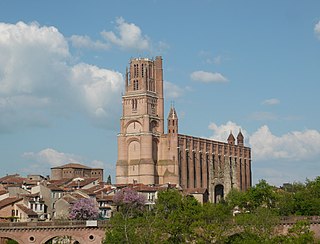
The Cathedral of Saint Ceciliaof Albi, also known as Albi Cathedral, is the seat of the Catholic Archbishop of Albi. First built in the aftermath of the Albigensian Crusade, the grim exterior resembles a fortress, but the interior is lavishly decorated with art and sculpture, a very ornate choir screen, and walls in bright blues and golds, in the Toulousian or Southern French Gothic style. It was begun in 1282 and was under construction for 200 years. It is claimed to be the largest brick building in the world. In 2010 the cathedral, along with its episcopal buildings, was designated a UNESCO World Heritage Site because of its unique architecture and the remarkable consistency in its design.

Clayton and Bell was one of the most prolific and proficient British workshops of stained-glass windows during the latter half of the 19th century and early 20th century. The partners were John Richard Clayton (1827–1913) and Alfred Bell (1832–1895). The company was founded in 1855 and continued until 1993. Their windows are found throughout the United Kingdom, in the United States, Canada, Australia and New Zealand.
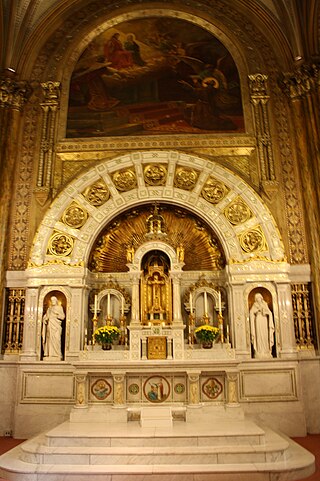
Tadeusz Żukotyński was a Polish count, professor, and painter.

The Hermitage of San Baudelio de Berlanga is an early 11th-century church at Caltojar in the province of Soria, Castile and León, Spain, 8 km south of Berlanga de Duero. It is an important example of Mozarabic architecture for its peculiarities, and was built in the 11th century, in what was then the frontier between Islamic and Christian lands. It is dedicated to Saint Baudilus or Baudel.

Nathaniel Hubert John WestlakeFSA (1833–1921) was a 19th-century British artist specialising in stained glass.

The Sanctuary of Atotonilco is a church complex and part of a World Heritage Site, designated along with nearby San Miguel de Allende, Guanajuato, Mexico. The complex was built in the 18th century by Father Luis Felipe Neri de Alfaro, who, according to tradition, was called upon by a vision of Jesus with a crown of thorns on his head with blood on his face and carrying a cross. The main feature of the complex is the rich Mexican Baroque mural work that adorns the main nave and chapels. This was chiefly the work of Antonio Martínez de Pocasangre over a period of thirty years. The mural work has led the complex to be dubbed the "Sistine Chapel of Mexico." The complex remains a place of worship and penance to this day, attracting as many as 5,000 visitors every week.

St Martin's Church stands in the centre of the town of Bowness-on-Windermere, Cumbria, England. It is an active Anglican parish church in the deanery of Windermere, the archdeaconry of Westmorland and Furness, and the diocese of Carlisle. The church is recorded in the National Heritage List for England as a designated Grade I listed building. Its benefice is united with that of St Anne's Church, Ings; St Cuthbert's Church, Kentmere; St James' Church, Staveley; Jesus Church, Troutbeck and St Mary's Church, Windermere.

Saint-Thomas-d'Aquin is a Roman Catholic church located in the 7th arrondissement of Paris, place Saint-Thomas-d’Aquin, between the rue du Bac and the boulevard Saint-Germain. The church is named for Saint Thomas Aquinas, a Dominican friar and priest, and influential philosopher and theologian in the 13th century. It was originally a chapel of an abbey of the Dominican order in Paris. Construction began in 1682, and the church was consecrated in 1682. The friars were expelled and the church was closed during the French Revolution, and was not returned to the Catholic church until 1802. During the 19th century, the City of Paris endowed the church with many fine examples of French religious art. The church was declared an Historic Monument in 1982.

Our Lady of Good Voyage, also known as the Seaport Shrine, is a Roman Catholic church located at 51 Seaport Boulevard in the Seaport District of Boston and in the Archdiocese of Boston. The shrine has 250 seats and holds Mass twice daily and three times on Sundays. The original chapel was located a short distance away and was built to serve the fisherman and dockworkers in what was then an industrial neighborhood.

Michael Healy was an Irish stained glass artist, one of a small number which included Wilhelmina Geddes, Evie Hone, and Harry Clarke, who achieved international recognition for their work in this medium in the first half of the 20th century. He also achieved some distinction as an illustrator and cartoonist early on in his artistic career, and as an ongoing recorder of Dublin street characters going about their daily business. Healy also occasionally painted in oil, both portraits and landscapes, exhibiting a small number of the latter during his lifetime.
The Robert Czakó Mural is a mural painting at St. Mary's Hostel in Alice Springs in the Northern Territory of Australia. It was painted by Hungarian Artist Robert Czakó in 1958. The mural depicts 22 biblical scenes and characters while also incorporating people living at the hostel at that time.




